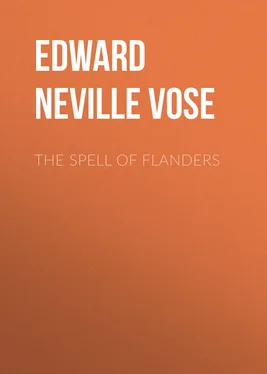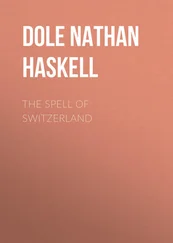Edward Vose - The Spell of Flanders
Здесь есть возможность читать онлайн «Edward Vose - The Spell of Flanders» — ознакомительный отрывок электронной книги совершенно бесплатно, а после прочтения отрывка купить полную версию. В некоторых случаях можно слушать аудио, скачать через торрент в формате fb2 и присутствует краткое содержание. Жанр: Путешествия и география, foreign_antique, foreign_prose, на английском языке. Описание произведения, (предисловие) а так же отзывы посетителей доступны на портале библиотеки ЛибКат.
- Название:The Spell of Flanders
- Автор:
- Жанр:
- Год:неизвестен
- ISBN:нет данных
- Рейтинг книги:5 / 5. Голосов: 1
-
Избранное:Добавить в избранное
- Отзывы:
-
Ваша оценка:
- 100
- 1
- 2
- 3
- 4
- 5
The Spell of Flanders: краткое содержание, описание и аннотация
Предлагаем к чтению аннотацию, описание, краткое содержание или предисловие (зависит от того, что написал сам автор книги «The Spell of Flanders»). Если вы не нашли необходимую информацию о книге — напишите в комментариях, мы постараемся отыскать её.
The Spell of Flanders — читать онлайн ознакомительный отрывок
Ниже представлен текст книги, разбитый по страницам. Система сохранения места последней прочитанной страницы, позволяет с удобством читать онлайн бесплатно книгу «The Spell of Flanders», без необходимости каждый раз заново искать на чём Вы остановились. Поставьте закладку, и сможете в любой момент перейти на страницу, на которой закончили чтение.
Интервал:
Закладка:
Every morning here at Bruges, and elsewhere throughout our pilgrimage, the Professor and I sallied forth between five and six o’clock to explore as many of the by-ways and quaint out-of-the-way corners as we could before breakfast. The sun rises in Belgium long before five, in fact it is light as early as three in the summer time, but we found very few people astir, and those who were up were usually engaged in the morning scrubbing of floors and sidewalks—a fact that made us keep pretty much to the middle of the road on these expeditions. Cleanliness is certainly honoured next to godliness in Belgium, for this morning ablution of the premises is universal—the big department stores at Brussels observing the custom as faithfully as the tiniest estaminet in the remotest hamlet. Every one, rich and poor, performs this rite, and the tourist could safely eat his breakfast off the doorstep of any house when it is over. Nor is the rest of the interior neglected, for every pot and pan that we could see within the little houses as we passed their doors shone with a lustre that bespoke perpetual polishing. On the other hand, the good vroue herself, or her maidservant, was not so clean, and it is in this respect that the people of Holland are superior, for they somehow manage to keep themselves as immaculate as their little houses.
It was at Bruges that the Professor had his first experience with the Belgian species of barber. Instead of the massive reclining chair, with which all Americans are familiar, one finds in all parts of Belgium, save the big tourist hotels and resorts, stiff little arm-chairs with immovable head rests that look as if they could never serve the purpose for which they are intended. In point of fact they do fairly well, once one becomes accustomed to them. Razors in Belgium, however, are almost invariably dull—especially with the lady barbers who abound in the smaller villages. Avoid these sirens if you value your skin, for they certainly will slice off a bit of it. On Sundays and holidays, it appears, their husbands officiate, but week days the better half does her best to accommodate the public—but her best is none too good, and the experience is usually a painful one for the unwary tourist.
The shave over, the barber says, “S’il vous plaît, monsieur,” or its equivalent in Flemish, motioning meanwhile toward a small wash basin that is placed in front of the chair. To the uninitiated this is somewhat bewildering, but the professor desires that monsieur will kindly wash his own face. The ablution performed, he proceeds to rub a piece of alum over the face, after which he sprays it with perfumed water, then dries and powders it much in the manner of the American barber. When one becomes accustomed to this performance—which costs two to three cents in the villages and five to ten cents in the large towns—he is apt to prefer it to the American method. Certainly it is vastly superior to the hot towel torture so deservedly caricatured some years ago by Weber and Fields. In the smaller villages of the industrial provinces we found that the first and second class distinction that one encounters everywhere in Belgium extends even to the barber’s chair. The rough clad workman is simply shaved—a few fierce scrapes with the razor and it is all over—and is left to wipe off the remnants of lather as best he can, usually with a red bandanna handkerchief. For this the charge is only two cents—the alum, the spraying and the powder being reserved for first-class patrons only.
On our way back to the hotel from these early morning promenades the Professor and I kept on the look-out for some patisserie where brioches or cuches au beurre could be had with a pot of coffee. This formed our usual breakfast for, it may as well be admitted right now, we did not feel that we could afford the extravagance of a three-franc breakfast at the hotel. The ladies were ready to join us by eight o’clock—before that hour it would be useless to look for a place open for business—and we conducted them to the patisserie we had discovered. The brioche , it may be remarked, is a light spongy preparation—half cake and half biscuit—while the cuche au beurre is apparently made from a kind of light pie-crust, rolled thin and built up in several layers with butter between. When served fresh and hot from the oven the latter is most delicious, but when cold it is as tough and soggy as a day-old griddle-cake. The usual charge for these delicacies was five centimes (one cent) each, and as three made a very substantial meal, and the coffee cost three or five cents per cup, our total expenditure for four people was less than two francs. If, as often happened—in addition to getting everything hot and delicious—we were served on little tables out of doors with a view of a cathedral or Hotel de Ville thrown in, we felt that we were getting a very good bargain indeed.
Of the Bruges of Charles the Good the most important existing monument is the great Cathedral of St. Sauveur, which was rebuilt by him after having been partially destroyed by fire in 1116, the work being completed in 1127. Probably very little of the structure as we see it to-day dates from this period, as the edifice has been enlarged and restored many times, much of it dating from the fourteenth and part from the sixteenth century—the era when architecture in Flanders flourished as never before or since. The tower was begun in 1116, continued in 1358, and its upper portions added during the last century, so that nearly eight hundred years elapsed before it was finally completed in its present form. Many writers speak of this tower as clumsy and unsightly, but to me it is one of the most majestic and stately structures in Flanders. At any rate, there is no other tower like it, and the way in which it lifts its castle-like mass of tawny brick high above the tiny houses that surround it is profoundly impressive. The lower part of the tower is Romanesque, being, no doubt, the portion erected under the supervision of Charles the Good. The rest is Gothic, if so unecclesiastical a style can be so denominated.
The interior of St. Sauveur dates in the main from a much later period than Charles the Good, and as we visited this interesting edifice several times an account of its later constructions and paintings will be found in a chapter devoted more particularly to the art treasures of Bruges. It is not the purpose of this book to weary the reader with detailed descriptions of this and every other “monument” in Flanders. For those who are interested in architectural details there are numerous works written by experts and discussing exhaustively—if not exhaustingly—every feature of technical importance. Our little party was not learned and these random jottings will therefore record only such facts as seemed interesting to the average American visitor. Nor would it be possible to attempt a detailed account of the pictures and sculptures, either at St. Sauveur or elsewhere. Many of the great Flemish churches are literally museums of early Flemish art and a mere catalogue of their contents would fill many pages. For the most part the works are of mediocre merit, but nearly every church possesses one or more masterpieces—which the uninformed visitor can generally distinguish by the fact that a charge is made to uncover them. At times this practice becomes a bit annoying, particularly when—in addition to paying the fee—one has to hunt around for half an hour to find the sacristan, who may live two or three blocks away; but, after all, it is the tourist who is under obligation for the privilege of visiting the churches when they are closed to the general public, and all the fees in Flanders add only a trifle to the expense account of one’s tour.
In St. Sauveur on the occasion of our first visit we were especially interested in a curious painting of the Crucifixion located in the Baptistry and said to be the earliest picture of the famous Bruges school in existence. The savants assign a date prior to 1400 to this work, the author of which is unknown.
Читать дальшеИнтервал:
Закладка:
Похожие книги на «The Spell of Flanders»
Представляем Вашему вниманию похожие книги на «The Spell of Flanders» списком для выбора. Мы отобрали схожую по названию и смыслу литературу в надежде предоставить читателям больше вариантов отыскать новые, интересные, ещё непрочитанные произведения.
Обсуждение, отзывы о книге «The Spell of Flanders» и просто собственные мнения читателей. Оставьте ваши комментарии, напишите, что Вы думаете о произведении, его смысле или главных героях. Укажите что конкретно понравилось, а что нет, и почему Вы так считаете.












